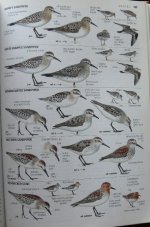The point that's missing is what, if anything, that has to do with what guidebook illustrations we prefer
I didn't introduce this "diversion", you did, around post 51.
You seem to be trying to imply that my inferior way of observing birds somehow invalidates my preference in the way guidebooks are illustrated.
I'm implying nothing of the sort. I'm commenting purely in relation to the point made elsewhere on the thread that "birding" through a camera is not necessarily the same as birding
per se.
But to address the original topic: the reason you're unlikely ever to see a really effective photographic bird guide is very obvious to me.
It is because painted illustrations can bring out subtle identification "clinchers" in a way that is all but impossible to do "to order" with photographs.
Bird guides are produced to deadlines and are under the same commercial restraints as any other product.
So what makes more sense to a publisher?
To wait until their photographer has tracked down examples of "almost impossible to split in the field" bird species A and bird species B, in all their plumage states, and has taken
definitive pictures of the ID differences at the best possible image quality, and in such detail that when the images are scaled down and mass produced in a field guide the tiny plumage and structural details are readily seen in the book?
Or does he just commission a knowledgeable bird illustrator to provide a few plates that bring out the feature differences (perhaps in an idealised way, but so what?) - in time, on budget, and guaranteed to convey the information that's needed to tell bird A and bird B apart?
A "no brainer", I believe...
This is, I reckon, why most photo guides use very average "stock" images of birds with no particularly useful ID information in the images, and also why photo guides tend to be cheap and cheerful.





